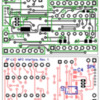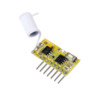Originally Posted by nvocc5:
When did they start the no e-bay link, this is the first I have heard of this.
I have no idea. All I know is a link was removed by someone from OGR yesterday.

As it says on their terms of service:
OGR Publishing, Inc. reserves the right to delete any message, at any time, for any reason.
"for any reason" is clear to me and the OGR person at least had the courtesy to say "no direct links to ebay". So be it, and I figure we should just leave it or else this entire thread might get deleted! 
Originally Posted by gunrunnerjohn:
You could use a 50 ohm pot or just solder a selected 3W resistor directly to the board. I found that 30 ohms dropped the volume by about 1/2 the apparent loudness, and was probably about as loud as I'd want it.
Yikes. Perish the thought of having to add a 3W resistor! The MP3 module I'm messing with has a non-volatile volume-control-button setting so I figure you set it once and forget about it. But in your case I suppose you could complicate matters  and add an external audio amp WITH volume control?
and add an external audio amp WITH volume control?

This would also then allow splitting the lower current "logic" supply from the higher current "power" supply. So this could be driven by the DACR and DACL outputs. I understand KISS, but there is something un-American about just putting in a power resistor to simply convert excess volume into heat. IMO that is.
I suppose one benefit is the spare audio channel is now buffered with higher current drive capability which could, for example, drive a motor or LEDs or who knows what.
I was thinking more about your use of "just" a 7805. So with 20V DC on the rectified bridge output, and (for the sake of argument) a 1 Watt audio load on the 5V regulator. 1 Watt = 5V x 200 mA average current...so the 7805 is burning 15V x 0.2A = 3 Watts.  .
.
So further throwing KISS out the window, I suppose a 99 cent step-down regulator integrated with your PCB and maybe even a provision to charge a superCap as you suggested for the recent thread on the Dark Trolley station stop.
![]()
![]()














